Overview
The article titled "10 Visual Design Elements Every Marketer Should Master" underscores the critical visual design principles that marketers must grasp to elevate their branding initiatives. It asserts that mastering elements such as:
- Size
- Visual hierarchy
- Balance
- Contrast
- Gestalt principles
is essential for crafting compelling marketing materials that captivate audiences and propel business success. Supported by examples of successful applications, the article illustrates the profound impact of design on consumer behavior, urging marketers to prioritize these elements in their strategies.
Introduction
Crafting a compelling visual narrative is no longer merely an option for marketers; it has become an absolute necessity in a world inundated with information. Mastering essential visual design elements significantly enhances brand storytelling, empowering businesses to forge deeper connections with their audiences. Yet, with the rapid evolution of design trends and consumer preferences, how can marketers ensure their visuals not only stand out but also effectively communicate their intended message?
This article delves into ten crucial visual design elements that every marketer must master to elevate their brand's presence and impact in an increasingly competitive landscape.
Overskies: Master Visual Design for Effective Brand Storytelling
Overskies stands at the forefront of design, expertly specializing in crafting engaging narratives through effective storytelling. Leveraging the capabilities of AI, we enhance our creative content generation, enabling scalable and tailored storytelling that resonates with audiences. Our creative approach intricately combines research with sophisticated content development techniques, ensuring that every visual design element plays a role in creating a cohesive narrative. This unwavering commitment to harnessing AI not only elevates the quality and efficiency of our creative output but also , empowering marketers to forge deeper connections with their audiences.
Scale: Utilize Size to Create Impactful Visuals
Effectively utilizing size in creation can significantly enhance visual impact, particularly when informed by AI-driven insights. Larger elements naturally attract the viewer's attention, making them ideal for emphasizing key messages or calls to action. Successful advertising campaigns often illustrate this; brands frequently or primary messages to capture immediate interest. Conversely, smaller elements de-emphasize less critical information, allowing the viewer to focus on what truly matters.
By leveraging AI to analyze customer preferences and performance data, Overskies empowers advertisers to make informed choices regarding the size of images, text, and other visual elements, ensuring that the most significant aspects are highlighted. Designers emphasize that size is a strong indicator; it conveys the relative significance and purpose of various elements within a design.
By strategically varying sizes, marketers can effectively guide consumer attention, enhancing engagement and driving desired actions while maintaining a consistent brand identity across all marketing channels.
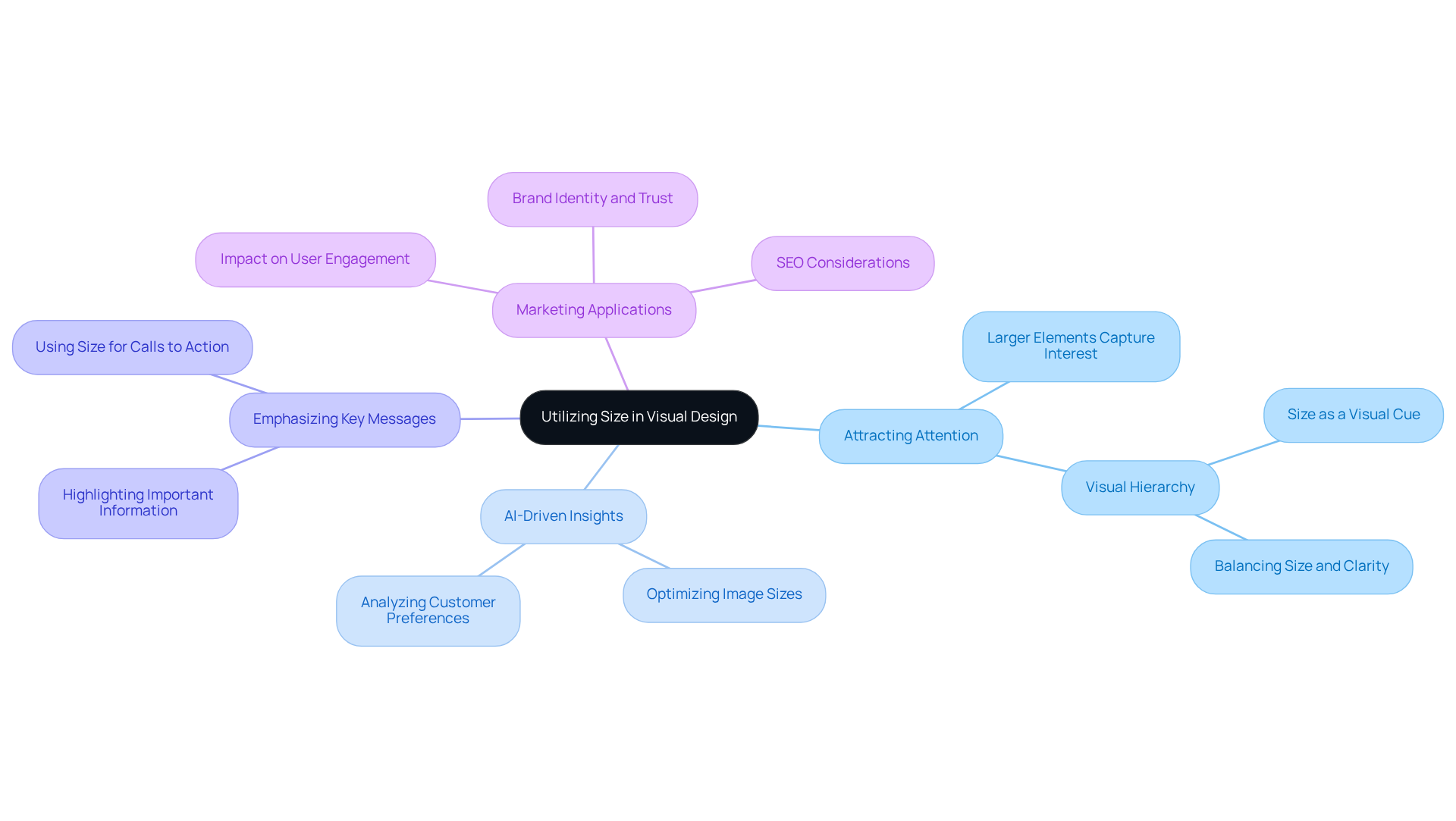
Visual Hierarchy: Organize Content for Optimal Engagement
Creating a robust hierarchy of images is essential for effectively directing the viewer's focus. This can be achieved by strategically manipulating the size, color, and placement of elements. For instance, employing larger fonts for headlines while reserving smaller fonts for body text establishes a clear distinction in importance. Marketers must prioritize content based on its relevance, as this significantly enhances both engagement and comprehension.
Design experts emphasize that a well-organized hierarchy can profoundly influence user interaction. Jessica Uttley observes that a compelling headline positioned at the top captivates users, motivating them to explore the content further. Moreover, incorporating generous whitespace around key messages not only elevates their perceived value but also facilitates easier information processing.
With the rise of AI, marketers can harness advanced insights to . AI empowers the rapid creation, testing, and refinement of various ad versions, ensuring that the most effective design elements are utilized. This approach enhances precision and efficiency in campaign optimization, ultimately improving ROI on marketing expenditures.
Effective examples of content organization are evident in successful marketing campaigns. For example, dynamic ads have demonstrated a twofold increase in click-through rates compared to static ads, underscoring the effectiveness of hierarchy in driving engagement. Furthermore, research indicates that using red buttons can boost conversions by 34%, showcasing how color choices can guide user focus toward critical actions.
By 2025, mastering and applying design hierarchy will be imperative for marketers aiming to capture attention in an increasingly crowded digital landscape. By aligning visual elements with user behavior—such as the prevalent Z-pattern and F-pattern reading styles—marketers can develop materials that not only attract but also retain viewer interest, ultimately leading to more effective communication and heightened engagement rates. Additionally, integrating AI-driven insights into visual aesthetics can ensure a cohesive brand identity across marketing channels, further enhancing overall campaign effectiveness.
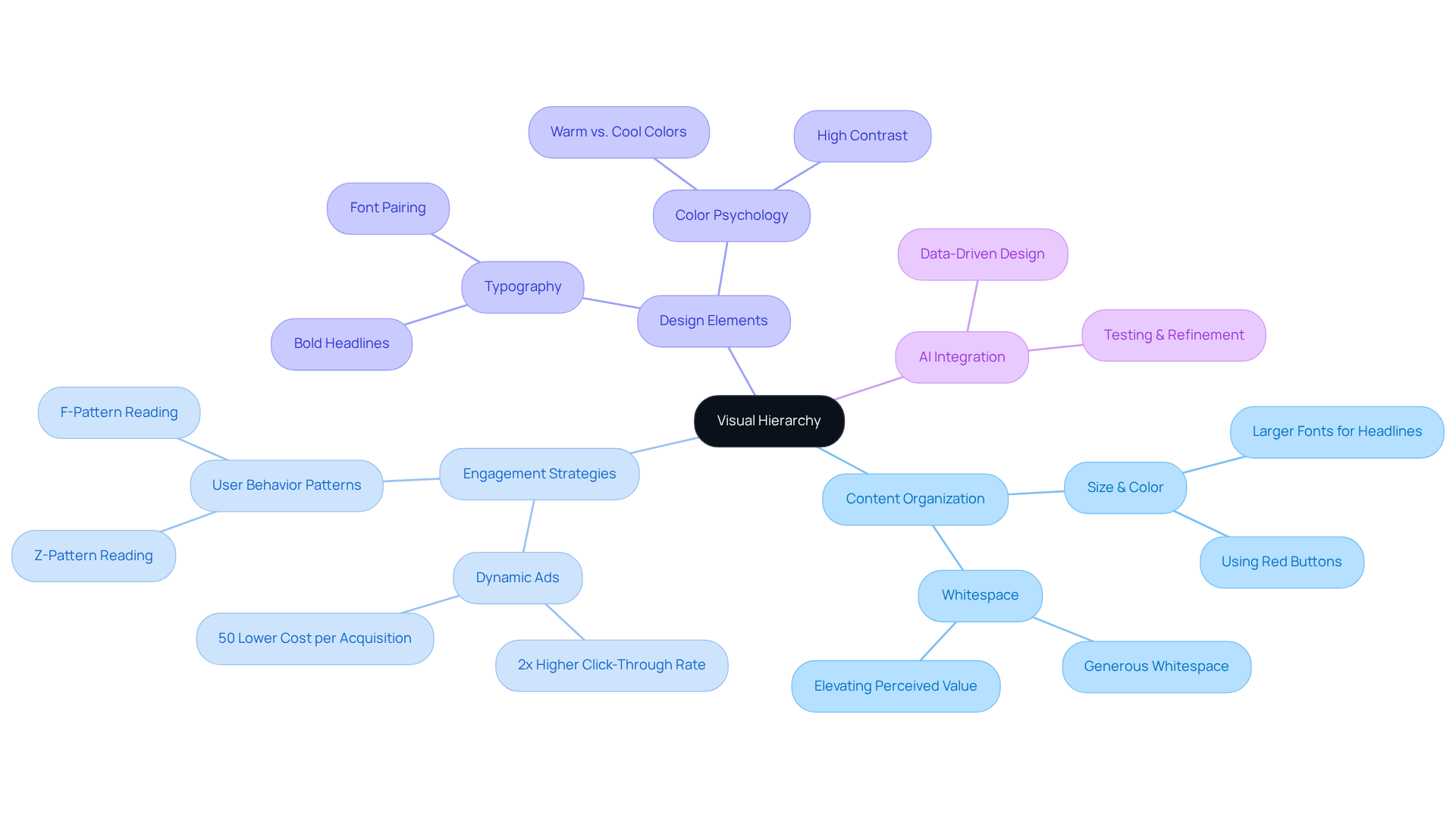
Balance: Achieve Visual Stability in Marketing Materials
Achieving balance in design is essential, accomplished through either symmetrical or asymmetrical arrangements of elements. Symmetrical balance imparts a sense of formality and stability, while asymmetrical balance introduces dynamism and intrigue. At Overskies, we assert that marketers must pursue a balance that feels organic and visually appealing by integrating visual design elements, ensuring that no single element dominates the others. This equilibrium is vital for establishing a through visual design elements across all marketing channels, which in turn enhances user engagement and elevates brand narratives. By integrating innovative AI-driven creative solutions, we can tailor media campaigns while preserving this critical balance, ensuring our approach remains ethical and focused on the consumer's experience.
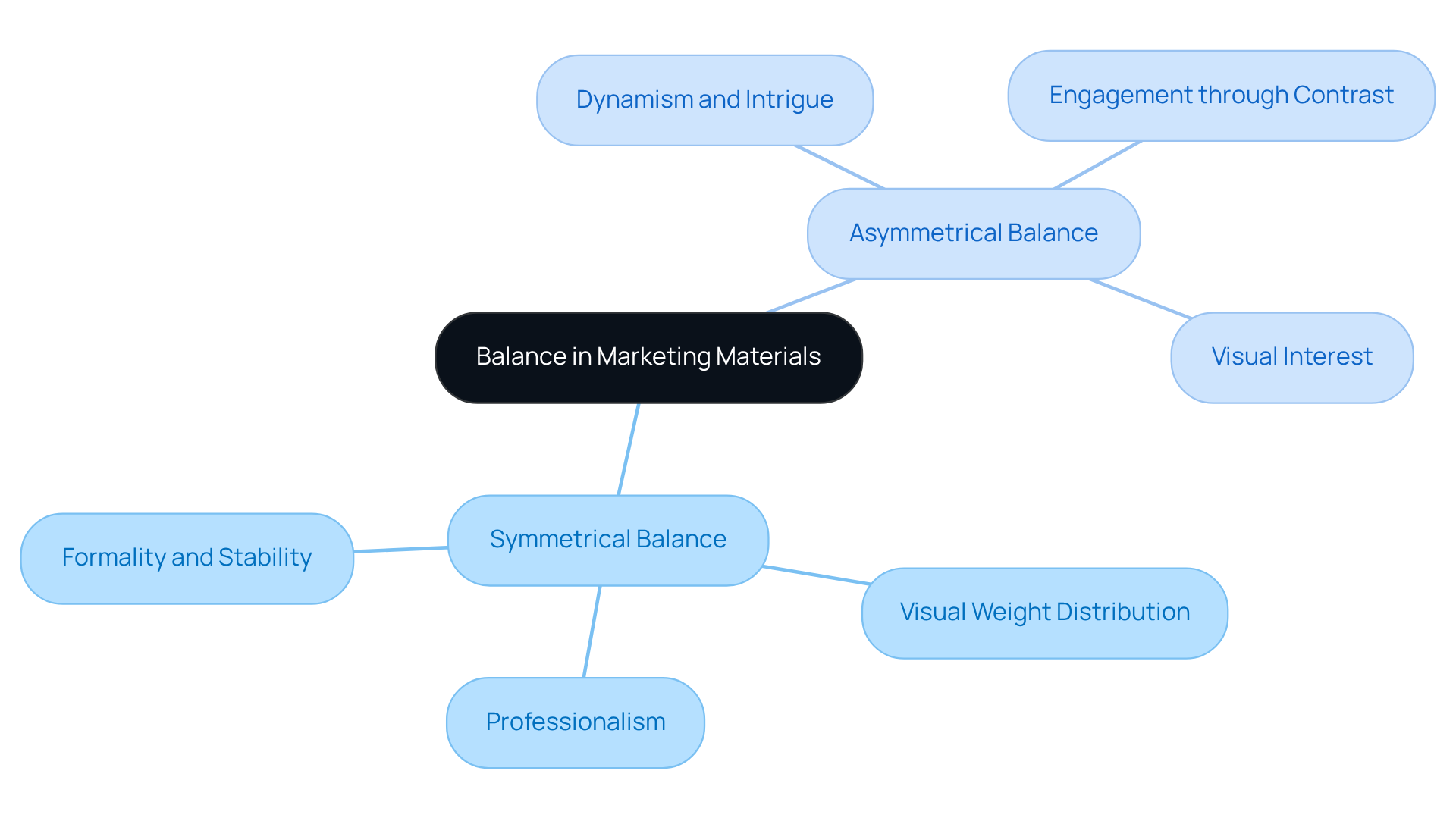
Contrast: Enhance Visibility and Focus in Design
Contrast stands as a fundamental principle of composition, achieved through variations in color, size, shape, and texture. For instance, employing light text on a dark background not only enhances readability but also directs focus to key messages. Effective use of contrast significantly elevates the visibility of essential information, making it stand out in a crowded graphical landscape.
Statistics reveal that high contrast layouts enhance readability and accessibility for individuals with sight impairments—an essential factor in advertising, where first impressions are critical. Marketers must strategically utilize contrast within their visual design elements to generate interest and ensure their creations are both aesthetically appealing and functional.
As industry specialists like Bill Hobbs assert, 'contrast is more than merely an aesthetic component—it’s essential for making your billboard distinctive and conveying your message successfully.' The can transform a typical advertisement into an engaging visual story that effectively utilizes visual design elements to resonate with viewers.
For example, Coca-Cola's iconic use of a bold red background with white text exemplifies how contrast reinforces brand identity while maximizing readability. Similarly, McDonald's effective use of yellow arches against red or black backgrounds further illustrates the power of contrast in advertising.
By prioritizing contrast in their layouts and rigorously testing them across devices, marketers can effectively communicate their messages and enhance user engagement.
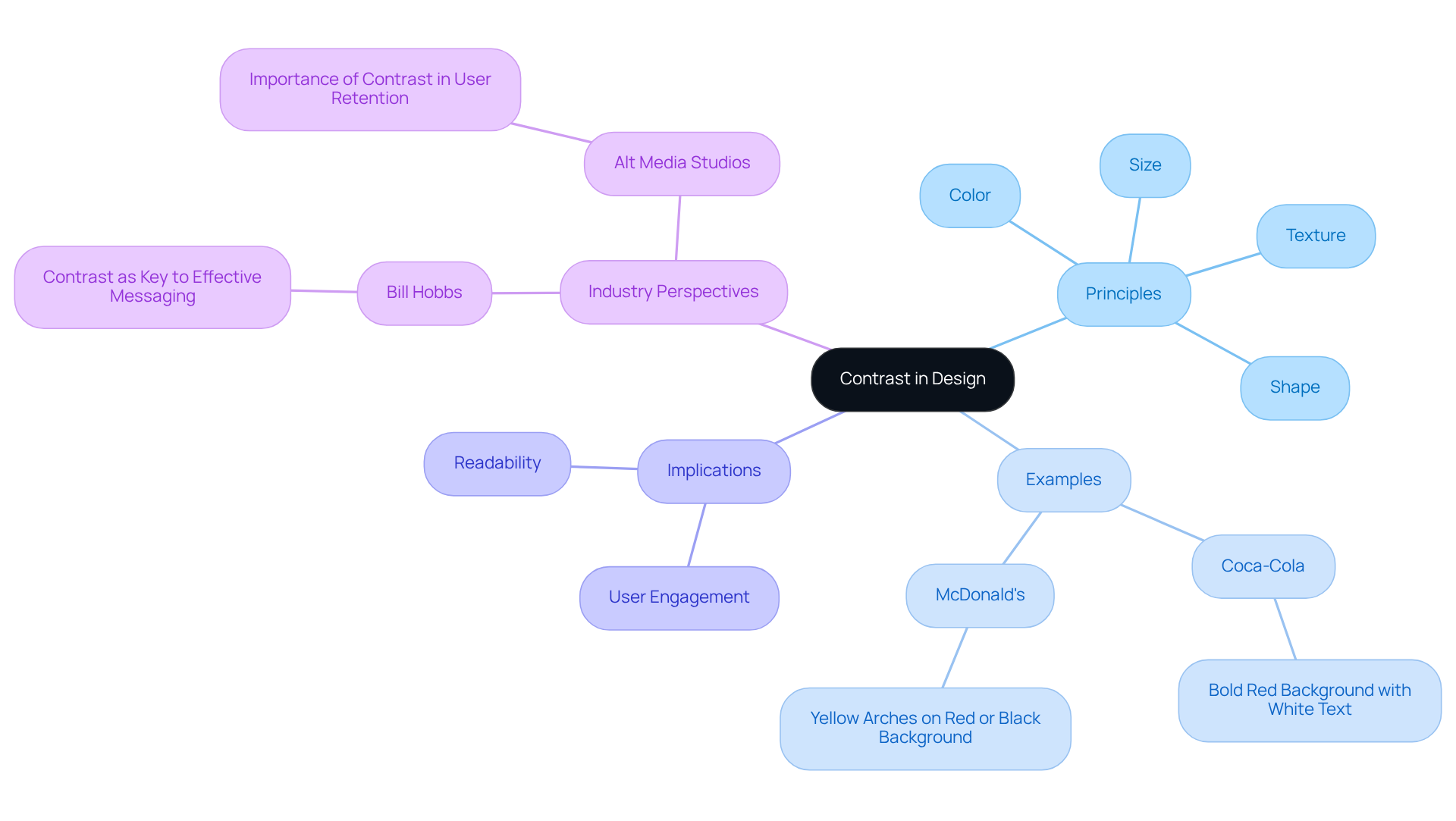
Gestalt Principles: Leverage Perception for Cohesive Design
Gestalt principles, such as proximity, similarity, and closure, are essential visual design elements that contribute to crafting cohesive designs which resonate effectively with viewers. Grouping related elements enhances organization and fosters clarity in communication.
The principle of closure enables audiences to perceive incomplete shapes as complete; for instance, in logos like the World Wildlife Fund, viewers intuitively fill in the missing parts of the panda's outline. Similarly, the principle of similarity suggests that items with shared traits are viewed as connected, which can be strategically utilized to establish a cohesive identity. This is illustrated by the Sun Microsystems logo, where two U shapes cleverly form the word 'SUN.'
Marketers must intentionally apply these principles to ensure their visual design elements convey messages that are easily understood and memorable. This ultimately enhances and brand recognition. As specialists in the field emphasize, leveraging perceptual tendencies through cohesive visual design elements is crucial for effective communication in advertising.
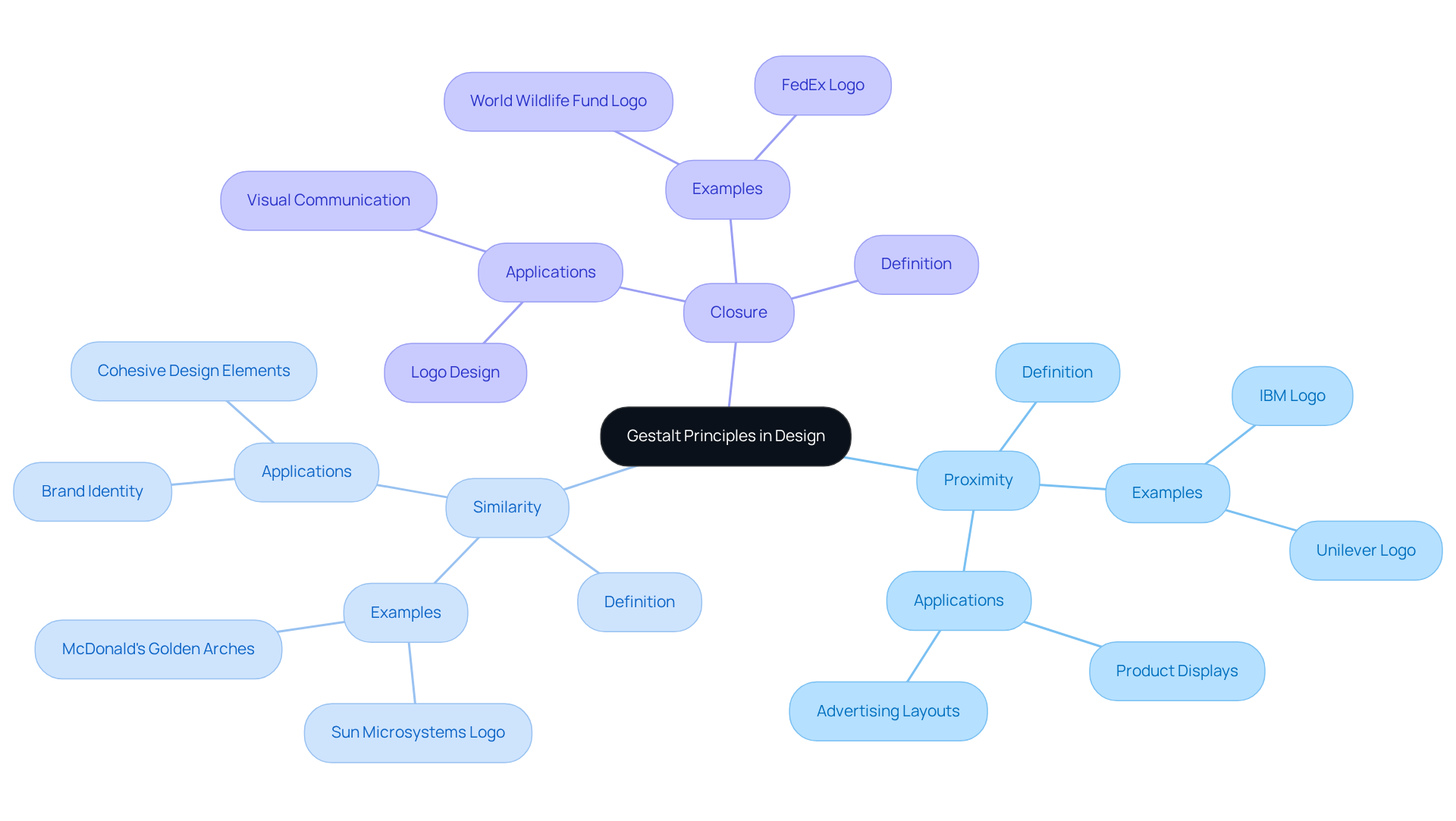
Importance of Visual Design Principles: Drive Marketing Success
The principles of visual design elements are essential for crafting impactful marketing materials that resonate with audiences and drive business success. At Overskies, we leverage cutting-edge AI technologies, including generative creation tools and data analytics, to elevate creative ideation and boost efficiency in our branding initiatives. By mastering these principles, marketers can significantly improve product recognition and user engagement, ultimately resulting in increased sales. For instance, studies show that eye-catching graphics can enhance social media engagement by up to 200%, illustrating the direct link between effective aesthetics and consumer interaction.
In 2025, companies that harness visual artistry expertise will stand out in a saturated marketplace. Key creative trends such as minimalism, AI-enhanced innovation, and cultural fusion will shape how businesses express their identity and values. A well-crafted logo, often regarded as the cornerstone of a brand's image, plays a critical role in establishing familiarity and trust among consumers.
Notable examples include firms that have successfully transformed their sales through strategic creative initiatives. Companies that understand the psychological effects of color and typography can create identities that deeply resonate with their target audiences, fostering emotional connections that drive loyalty.
Marketing leaders emphasize the importance of visual design elements in achieving success. As one expert noted, 'Effective graphic composition improves user experience by establishing a clear hierarchy, directing the user’s focus, and simplifying complex information for better understanding.' This highlights that visual design elements are not merely a focus; they act as a that shapes consumer perceptions and behaviors.
At Overskies, our proprietary 6-step Brand Storytelling Process guarantees that our creative efforts align with our clients' unique narratives, enhancing their market presence. In conclusion, investing in aesthetic principles is not just beneficial but vital for professionals aiming to elevate their company's visibility and increase sales in an increasingly competitive digital landscape.
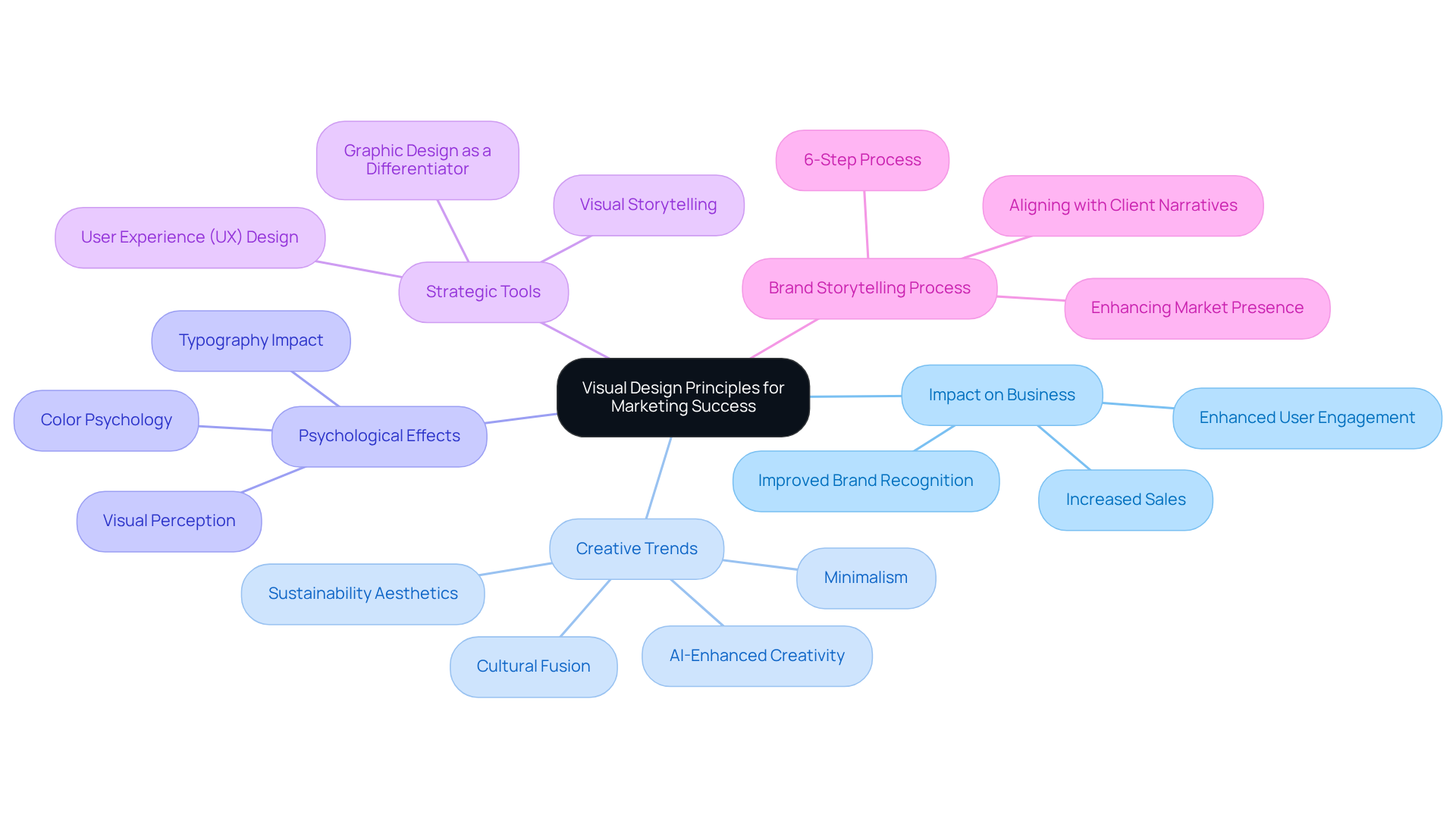
Applying Visual Design Principles: Strategies for Marketers
To effectively implement visual design elements, professionals must establish clear objectives and gain a profound understanding of their target audience. Mood boards serve as an essential tool in this process, enabling marketers to visualize concepts and ensure alignment with the company's identity. By curating a selection of visual design elements such as images, colors, and typography, mood boards assist in capturing the desired aesthetic and emotional tone of a business. For instance, Medihuanna, a medical cannabis label, adeptly employed a mood board to represent its core values of credibility, innovation, and natural elements, steering the creative process toward a cohesive identity.
Creating effective mood boards involves selecting impactful visual design elements that resonate with the brand's message while avoiding clutter. Savvy marketers emphasize the importance of establishing goals prior to initiating the creative process. This organized approach not only aligns the creator's vision with client expectations but also integrates visual design elements, fostering collaboration among team members and thereby enhancing the overall creative process.
At Overskies, we champion the power of human-first thinking, prioritizing ethical storytelling and client-centric strategies that forge lasting connections. Evaluating diverse concepts and collecting feedback is vital for continuous improvement. By sharing mood boards with stakeholders and utilizing feedback methods—such as color-coded sticky notes for positive and negative suggestions—professionals can refine their design strategies based on collective insights. This iterative process ensures that the final creation not only meets aesthetic standards but also effectively conveys the company's narrative. Ultimately, mastering the art of mood boards allows professionals to incorporate visual design elements that empower them to resonating with their audience and driving engagement.
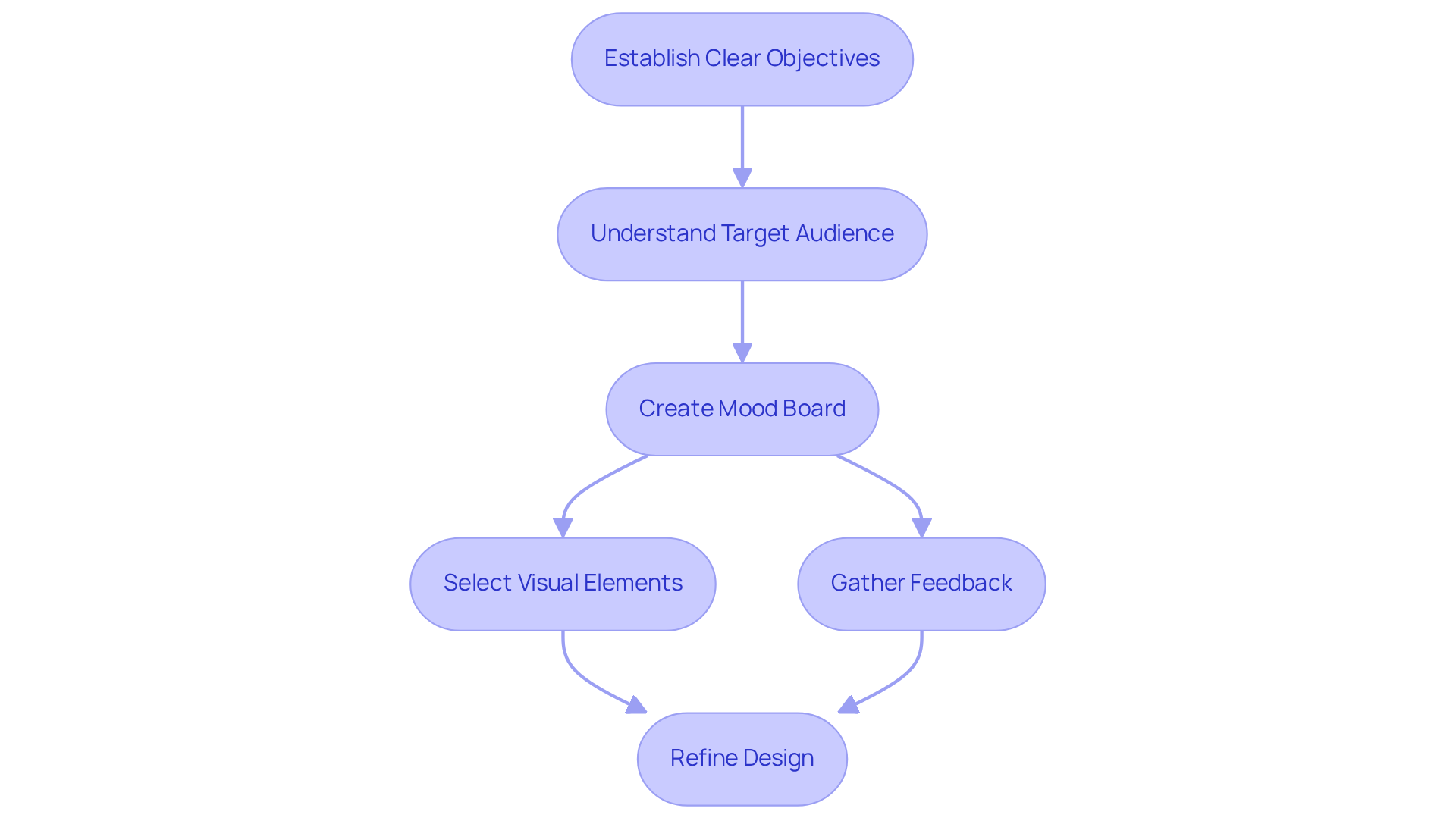
Common Visual Design Mistakes: What Marketers Should Avoid
Frequent visual errors can significantly undermine brand perception and messaging. Cluttered layouts, poor color choices, and inconsistent branding rank among the most detrimental mistakes marketers can commit, particularly when they fail to incorporate effective visual design elements. As marketing analyst Liam Bayford aptly states, 'Poor graphic aesthetics undermine marketing efforts quicker than you can say, Comic Sans.' Overloading layouts with excessive fonts or colors creates confusion, diluting the message and resulting in a .
Moreover, failing to establish a clear visual hierarchy with appropriate visual design elements can obscure essential information, hindering audience engagement with the content. A cluttered website or confusing graphics can elevate bounce rates, as users may exit swiftly upon encountering mismatched elements or poor navigation.
Companies that have successfully navigated these challenges prioritize simplicity and clarity, ensuring that each element serves a distinct purpose. By focusing on unified and impactful visual design elements, professionals can enhance brand perception and foster greater interaction with their target audiences.
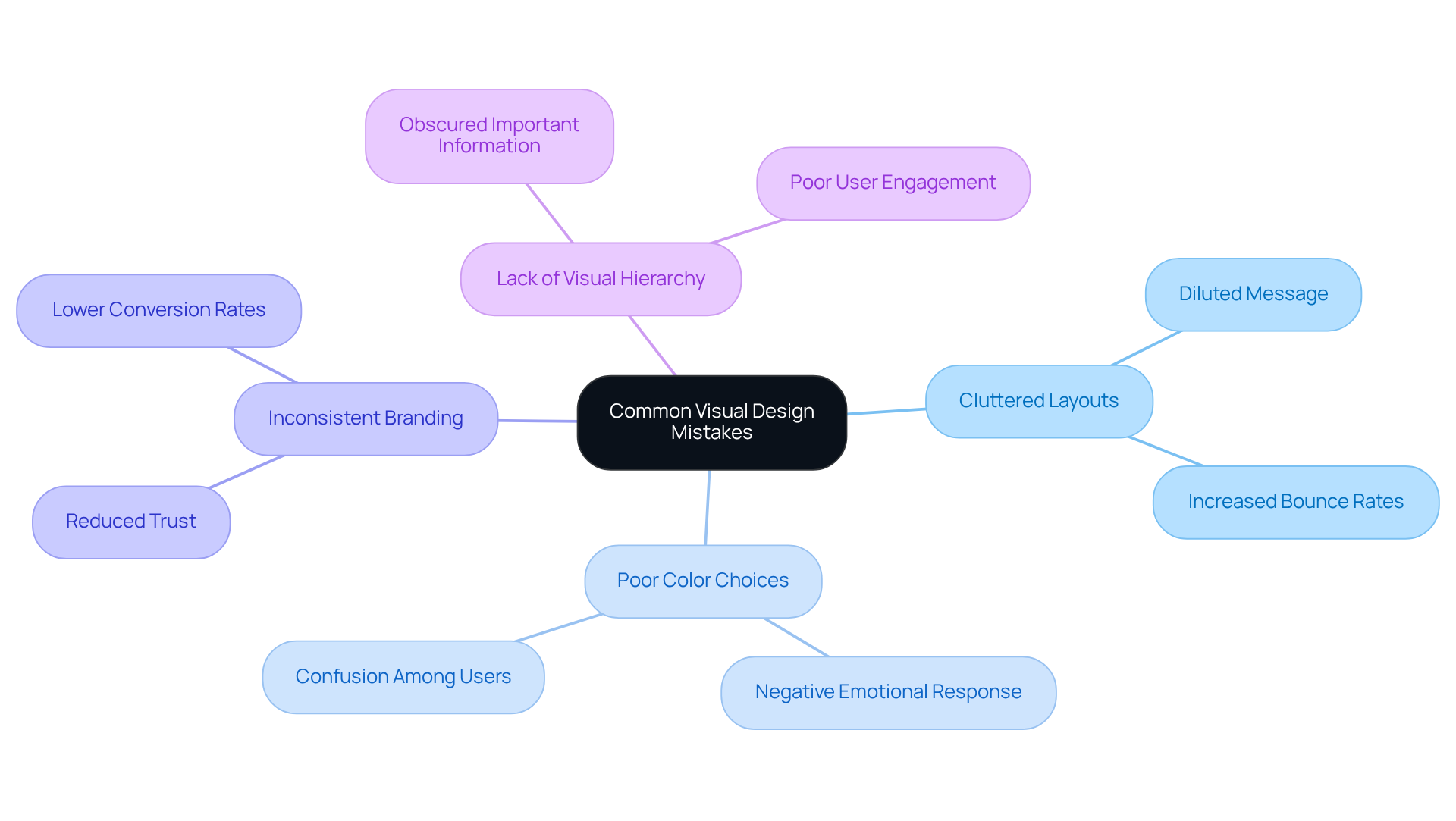
Refining Visual Design Skills: Continuous Improvement for Marketers
To thrive in today's dynamic market, marketers must prioritize to enhance their visual design elements while adopting a human-first approach. Recognizing that customers are individuals, not mere data points, is crucial for effective branding and consumer engagement.
Participation in workshops has proven to significantly elevate creative skills, with research indicating that practical training can lead to a 30% increase in proficiency. Engaging with design communities and leveraging online resources not only yields valuable insights but also cultivates creativity and innovation.
Marketing specialists emphasize that continuous learning is imperative; as Christine Cook from Bloomberg Media notes, equipping professionals with the right skills enables them to achieve more with fewer resources. Moreover, embracing a mindset that perceives learning as an opportunity to push boundaries and experiment is vital for ongoing improvement.
By actively soliciting feedback from peers and collaborating with senior professionals, marketers can adeptly adapt their strategies. This commitment to enhancement not only boosts individual efficiency but also empowers companies to forge deeper connections with their audiences in an increasingly visual economy through the use of visual design elements.
Furthermore, as digital creation tools advance swiftly, staying abreast of these developments is essential for maintaining a competitive edge. Marketers should allocate time each week to explore new visual design elements and techniques, ensuring they uphold brand values while engaging meaningfully with their audience.
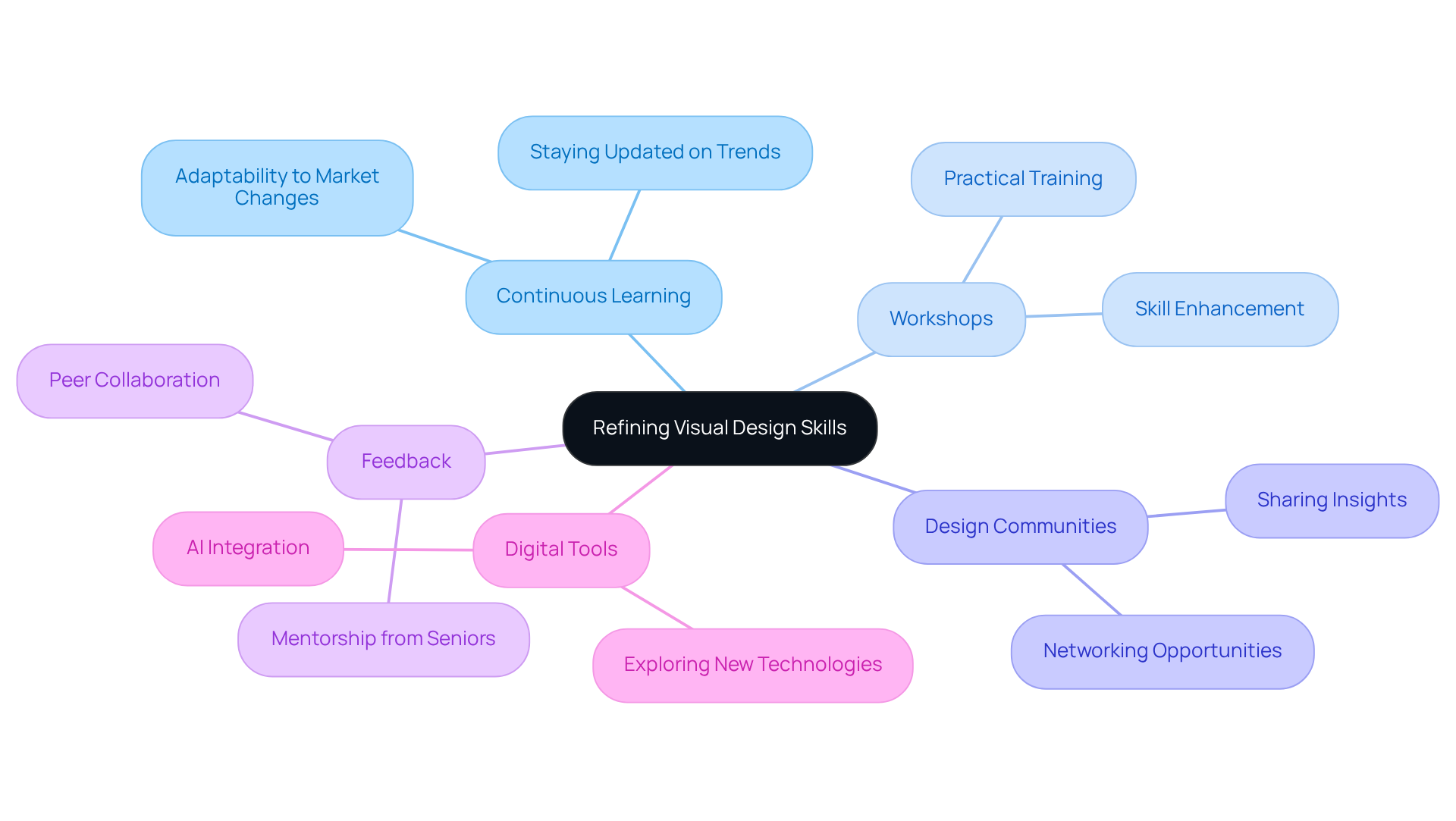
Conclusion
Mastering visual design elements is crucial for marketers aiming to create impactful brand narratives and engage effectively with their audiences. The integration of size, visual hierarchy, balance, contrast, and Gestalt principles not only enhances the aesthetic appeal of marketing materials but also drives consumer engagement and brand recognition. By leveraging these essential elements, marketers can foster deeper connections with their audience, ultimately leading to increased sales and brand loyalty.
Throughout the article, key insights were highlighted, such as:
- The importance of using size strategically to capture attention.
- Organizing content through visual hierarchy for optimal engagement.
- Achieving balance for a cohesive look.
- The role of contrast in enhancing visibility.
- The application of Gestalt principles in creating memorable designs.
These principles serve as the foundation for effective marketing strategies in an increasingly competitive landscape.
In summary, prioritizing visual design principles is not merely an option but a necessity for marketers looking to thrive in 2025 and beyond. Continuous improvement in design skills, along with a commitment to understanding audience perceptions, will empower professionals to craft compelling brand stories that resonate deeply. Embracing these strategies will not only elevate individual marketing efforts but also contribute to the overall success of brands in a visually-driven world.
Frequently Asked Questions
What is Overskies and what does it specialize in?
Overskies is a design firm that specializes in crafting engaging narratives through effective storytelling, leveraging AI to enhance creative content generation for scalable and tailored storytelling that resonates with audiences.
How does Overskies utilize AI in its design process?
Overskies uses AI to improve the quality and efficiency of creative output, allowing for sophisticated content development techniques that enrich narratives and empower marketers to connect deeper with their audiences.
What role does size play in creating impactful visuals?
Size is crucial in visual design as larger elements attract attention and emphasize key messages, while smaller elements de-emphasize less critical information. AI-driven insights help advertisers make informed choices about the size of images and text to highlight significant aspects.
What is visual hierarchy and why is it important?
Visual hierarchy is the organization of content to direct viewer focus effectively. It is important because it enhances engagement and comprehension by prioritizing content based on relevance, using size, color, and placement to create a clear distinction in importance.
How can marketers optimize their design strategies using AI?
Marketers can use AI to rapidly create, test, and refine various ad versions, ensuring the most effective design elements are utilized, which enhances precision and efficiency in campaign optimization.
What are some effective examples of content organization in marketing?
Successful marketing campaigns often use dynamic ads to achieve higher engagement, such as a twofold increase in click-through rates compared to static ads. Additionally, research indicates that using red buttons can boost conversions by 34%.
Why is mastering design hierarchy important for marketers by 2025?
By 2025, mastering design hierarchy will be essential for marketers to capture attention in a crowded digital landscape. Aligning visual elements with user behavior, such as prevalent reading patterns, will help develop materials that attract and retain viewer interest.
How does integrating AI-driven insights benefit brand identity?
Integrating AI-driven insights into visual aesthetics ensures a cohesive brand identity across marketing channels, enhancing overall campaign effectiveness and improving communication with audiences.
.png?width=250&height=153&name=CSI-OverskiesRebrand_LOGO-01(smaller).png)

.png?width=100&height=61&name=CSI-OverskiesRebrand_LOGO-01(smaller).png)


.png?width=88&name=CSI-OverskiesRebrand_LOGO-01(smaller).png)

